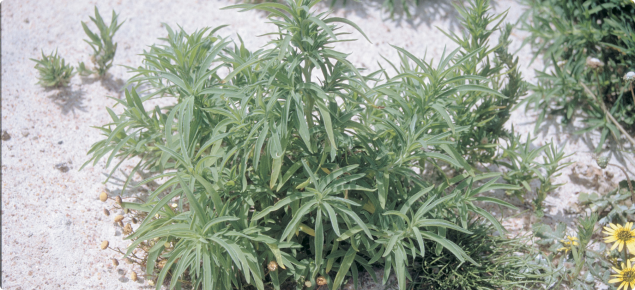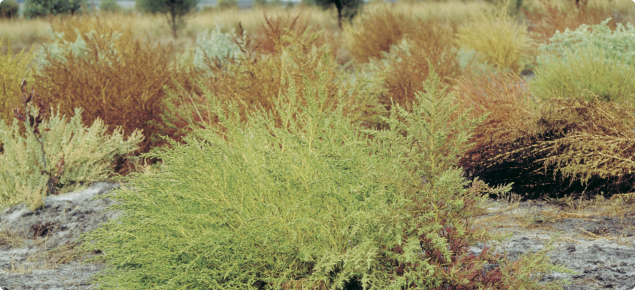Form: herbaceous — annual
Status: eradicated from WA
Kochia, also know as burning bush, summer cypress, mock cypress is a summer growing plant native to eastern Europe and western Asia. It was introduced to salt affected areas in Western Australia in 1990/91 but spread rapidly to non-salt affected areas and roadsides.
Appearance
Kochia is an erect annual, growing 20-150 centimetres tall. As the plant ages, its colour often changes to pale yellow, pink and dull brown. Dead plants break off at ground level and are blown (as tumbleweeds) by the wind over large distances, scattering seeds as they travel.
Stems: It usually has a main stem that bears many branched, upwardly-curving side stems that give the plant a dense, compact appearance. The young shoots are often hairy.
Leaves: Flat and elongated, up to 50 millimetres long and eight millimetres wide, with three longitudinal veins on the underside.
Flowers: Small indistinct flowers are borne on short dense spikes in axils of upper branches or at ends of branches; base of flower surrounded by five-lobed calyx with horizontal wings that persist around spherical fruit.
Fruit: Small (two millimetres across), star shaped and contains a single seed.
Kochia resembles several other summer-growing weeds including stinkwort, amaranths and roly-poly.
Online weed identification training
Login or set up a new account on DPIRDs online training site to access:
- a training course on how to identify kochia and report it.
- training material that you can use to teach community groups how to identify kochia.
Agricultural and economic impact
Considered a threat to cropping because it is an allelopath (produces substances that suppress plant growth) reducing pasture and crop production. Notorious for its large size (shading developing crop plants) and its ability to spread fast. Is resistant to insect attack.
Shoots of kochia have been shown to be toxic to a variety of grazing animals, due to high levels of oxalate (up to 4.7% soluble and 11.4% total), nitrate (up to 2.2%) and alkaloid (up to 1.2%). Plants that accumulate more than 1.5% of dry matter of nitrate are potentially toxic. There are many reports from the United States of clinical diseases in sheep and cattle that consumed kochia (signs included depression, dehydration, weight loss, muscular weakness, photosensitisation, runny eyes and a crusty muzzle).
Kochia can infest many different crops as well as pastures, firebreaks, fencelines, roadsides and railway lines. It develops multi-herbicide resistance and can be toxic to livestock. Large patches of tumbled plants can damage fences and are a fire hazard.
Declared pest category
The Western Australian Organism List (WAOL) contains information on the area(s) in which this pest is declared and the control and keeping categories to which it has been assigned in Western Australia (WA). Search for kochia in the WAOL using the scientific name Bassia scoparia.
Requirements for land owners/occupiers and other persons
Requirements for land owners/occupiers and other persons if this pest is found can be sourced through the declared plant requirements link.
Search > detect > report
| MyPestGuide™ Reporter | Pest and Disease Information Service (PaDIS) |
Detectability: hard to find. Kochia could easily be confused with common weeds such as fleabane (Conyza spp) or stinkwort (Dittrichia graveolens), or ‘tumbleweeds’ such as Amaranthus spp. or Salsola australis.
Who should look for it: landholders who planted it previously and other landholders in the vicinity of eradicated infestations.
When to find it: kochia is most conspicuous in summer and autumn.
Where to look for it: in and around paddocks where it had been sown originally and eradicated. The tumbling nature of kochia means it could be seen rolling across paddocks and building up against fencelines.
Control method
Report the presence of this organism before undertaking a control measure. Control methods for this declared plant can be found through the kochia control link.
Management calendar
A faded icon means it occasionally occurs in that time frame.




